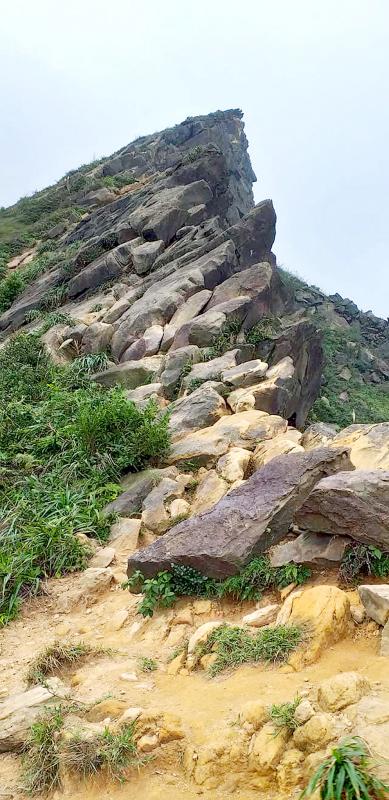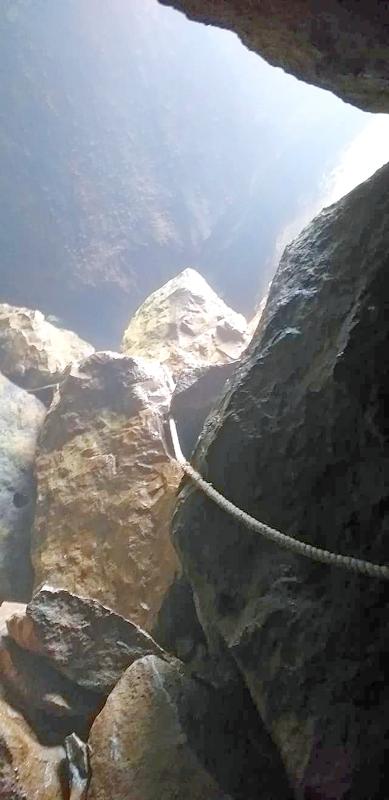Warnings and rumors circulated for months: dead bodies have been found in rock crevices hundreds of meters below Stegosaurus Ridge’s (劍龍稜) spiky backbone; dozens have lost their nerve on the trickiest, ropeless, exposed section; some even say that the ridge is cursed by evil spirits.
With all the mystique surrounding it, the hike up New Taipei City’s Stegosaurus Ridge had to be done. And one thing was for sure: this hike is an endeavor not to be taken lightly. But with level 3 lockdown hopefully easing up in the foreseeable future, more than a few have probably put on some weight and are thinking about how to take it off.
Stegosaurus Ridge is a great option to accomplish this in a half a day in northern Taiwan, which begins at “Nanya Peculiar Rock” (南雅奇石), and you almost certainly make it out alive, a couple of kilos lighter, with your metabolism in high gear.

Photo: Greg McCann
CONQUERING THE BEAST
To conquer this beast of a climb, one needs first a pair of gloves for handling ropes for going up and down the trail’s stony ridgeline, which actually does in several sections resemble the upright “armor plates” of a stegosaurus. False summits abound, and frequent rests are required for all but the super-fit.
But those rest stops afford one stupendous views of the Pacific Ocean — including one of Keelung Islet — that are probably unparalleled. And the next thing one needs is for the rest stops: water, and lots of it. Two liters would be the absolute minimum amount to bring, and maybe three to be safe, with one preferably heavy on electrolytes.

Photo: Greg McCann
Up and up we go, which is almost always the case when hiking in Asia where the lowlands have been converted for human use. And if the views out to sea are jaw-dropping, the geography of what you are hiking over is equally as striking.
It is as if one is hiking over an actual petrified stegosaurus, a gigantic dinosaur that got stuck in the quicksand 65 million years ago, and gave up and died. And what an enormous animal it is as the hiker will crest ridge upon ridge with seemingly no end in sight, as if one is trekking back into the ancient past itself.
At 555 meters the weary traveler will find a most welcome rest stop, a flat area with plenty of places to sprawl out and rest one’s legs. But you’re not finished yet as you’ve got 149 meters more to climb, as the ridge peaks out at 714 meters. That might not sound gargantuan, but keep in mind that you will begin at sea level.

Photo: Greg McCann
THE FINAL STRETCH
The hiker will find himself with a couple of final obstacles, including a delicate maneuver over an exposed section of sheer rock without a rope to hold on to. This goes on for about 15 meters, and it’s probably best not to look down. Over-exertion could be setting in at this point for those of us hiding away in our rooms too long, but you’re still not done, with several more rope-assisted climbs and scrambles over and around rugged peaks and walls of stone.
The main mountain section ends with a steep drop down a natural chute, where two thick ropes lower you to safety. It seems like it’s over and that the going should be easy. But you’re not off the mountain yet.

Photo: Greg McCann
There is some spelunking to do at Teapot Mountain (茶壺山). Earthquakes have caused former entrances to this small cave to shift and collapse, but you still need to go through it. It’s down into the dark you go, like a final portal that brings one back to modern times and our creature comforts.
Once you find your way through there and drop down to level ground, it’s a fairly long slog by steps and road to Cyuanji Temple (?勸濟堂), where buses and taxis, as well as restaurants, await.
If you still have some juice left in you, a walk of another 200 meters will take you to Kukutsu POW Camp Memorial, which commemorates a site where the Japanese held American, British and other POWs in appalling conditions during World War II.

Photo: Greg McCann
My hiking mojo was blown and this recent trek, and I didn’t make it to the memorial. Next time.

Photo: Greg McCann

Photo: Greg McCann

Photo: Greg McCann

Photo: Greg McCann

This is the year that the demographic crisis will begin to impact people’s lives. This will create pressures on treatment and hiring of foreigners. Regardless of whatever technological breakthroughs happen, the real value will come from digesting and productively applying existing technologies in new and creative ways. INTRODUCING BASIC SERVICES BREAKDOWNS At some point soon, we will begin to witness a breakdown in basic services. Initially, it will be limited and sporadic, but the frequency and newsworthiness of the incidents will only continue to accelerate dramatically in the coming years. Here in central Taiwan, many basic services are severely understaffed, and

Jan. 5 to Jan. 11 Of the more than 3,000km of sugar railway that once criss-crossed central and southern Taiwan, just 16.1km remain in operation today. By the time Dafydd Fell began photographing the network in earnest in 1994, it was already well past its heyday. The system had been significantly cut back, leaving behind abandoned stations, rusting rolling stock and crumbling facilities. This reduction continued during the five years of his documentation, adding urgency to his task. As passenger services had already ceased by then, Fell had to wait for the sugarcane harvest season each year, which typically ran from

It is a soulful folk song, filled with feeling and history: A love-stricken young man tells God about his hopes and dreams of happiness. Generations of Uighurs, the Turkic ethnic minority in China’s Xinjiang region, have played it at parties and weddings. But today, if they download it, play it or share it online, they risk ending up in prison. Besh pede, a popular Uighur folk ballad, is among dozens of Uighur-language songs that have been deemed “problematic” by Xinjiang authorities, according to a recording of a meeting held by police and other local officials in the historic city of Kashgar in

The People’s Republic of China (PRC) was out in force in the Taiwan Strait this week, threatening Taiwan with live-fire exercises, aircraft incursions and tedious claims to ownership. The reaction to the PRC’s blockade and decapitation strike exercises offer numerous lessons, if only we are willing to be taught. Reading the commentary on PRC behavior is like reading Bible interpretation across a range of Christian denominations: the text is recast to mean what the interpreter wants it to mean. Many PRC believers contended that the drills, obviously scheduled in advance, were aimed at the recent arms offer to Taiwan by the